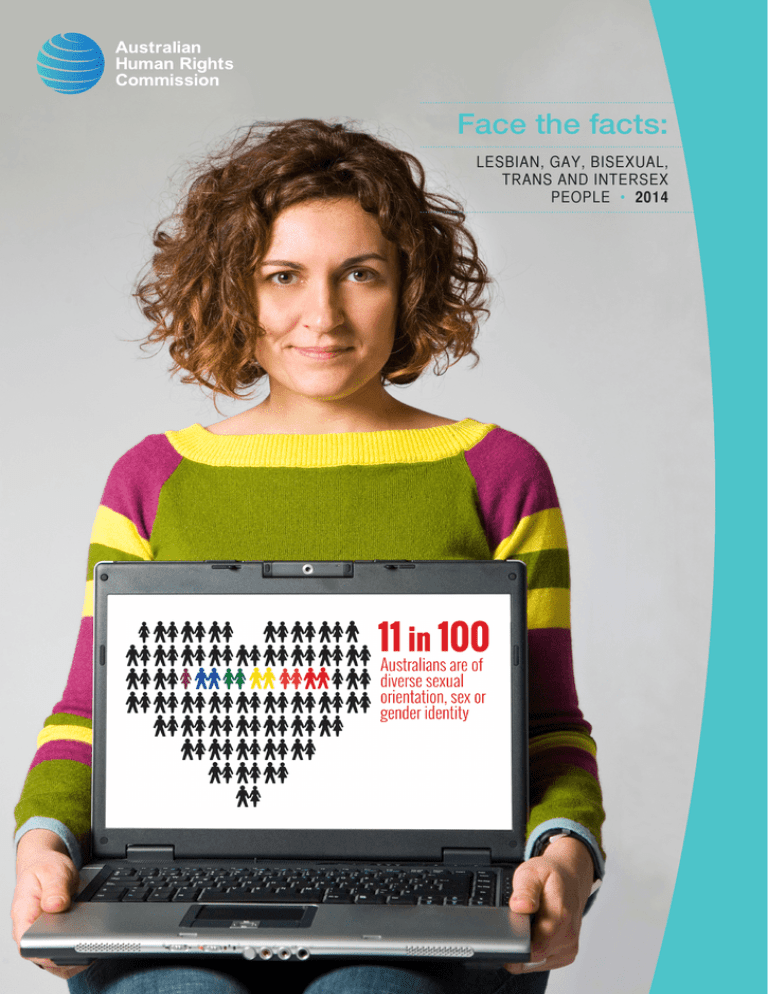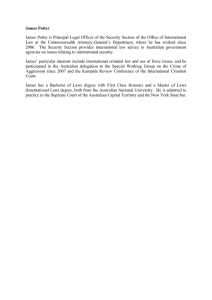
Face the facts:
LESBIAN, GAY, BISEXUAL,
TRANS AND INTERSEX
PEOPLE • 2014
The Australian Human Rights Commission encourages the dissemination and exchange of information provided in this publication.
All material presented in this publication is provided under Creative Commons Attribution 3.0 Australia, with the exception of:
• the Australian Human Rights Commission Logo
• photographs and images
• any content or material provided by third parties.
The details of the relevant licence conditions are available on the Creative Commons website, as is the full legal code for the
CC BY 3.0 AU licence.
Attribution
Material obtained from this publication is to be attributed to the
Australian Human Rights Commission with the following copyright notice:
© Australian Human Rights Commission 2014.
Face the Facts: Lesbian, gay, bisexual, trans and intersex people • 2014
ISBN 978-1-921449-67-3
Design and layout Dancingirl Designs
Infographic Design Firefly Interactive
Content James Iliffe, Black and White Media Australia
Electronic format
This publication can be found in electronic format on the website of the Australian Human Rights Commission:
http://www.humanrights.gov.au/publications
Contact details
For further information about the Australian Human Rights Commission, please visit
www.humanrights.gov.au or email communications@humanrights.gov.au.
You can also write to:
Communications Team
Australian Human Rights Commission
GPO Box 5218
Sydney NSW 2001
www.humanrights.gov.au/face-facts
Face the Facts: Lesbian, gay, bisexual, trans and intersex people • 2014 • 1
Lesbian, gay,
bisexual, trans and
intersex people
Equality and freedom from discrimination are fundamental
human rights that belong to all people, regardless of sexual
orientation, gender identity or because they are intersex.
On 1 August 2013, the Sex Discrimination Act 1984 was
amended to make discrimination on the basis of a person’s
sexual orientation, gender identity and intersex status against
the law.
Despite this important step forward, lesbian, gay, bisexual,
trans and intersex (LGBTI) people in Australia still experience
discrimination, harassment and hostility in many parts of
everyday life; in public, at work and study, accessing health
and other services and securing proper recognition of their
sex in official documents.
About
• Australians of diverse sexual orientation, sex or
gender identity may account for up to 11 per cent of
the Australian population.1
• Same-sex couples make up about one per cent of
all couples in Australia. In 2011, there were around
33,700 same-sex couples in Australia, including
17,600 male same-sex couples and 16,100 female
same-sex couples.2 The number of same-sex couples
more than tripled between 1996 and 2011.3
• In 2011, there were 6,300 children living in same-sex
couple families, up from 3,400 in 2001. Most of these
children (89 per cent) are in female same-sex couple
families.4
• There are no firm figures for Australia’s intersex
population. Estimates range from one in 2,000 births
to four per cent of the population.5
2
Key issues for LGBTI
people
• A large number of LGBTI people hide their sexuality or
gender identity when accessing services (34 per cent),
at social and community events (42 per cent) and
at work (39 per cent).6 Young people aged 16 to 24
years are most likely to hide their sexuality or gender
identity.7
• LGBTI young people report experiencing verbal
homophobic abuse (61 per cent), physical
homophobic abuse (18 per cent) and other types of
homophobia (nine per cent), including cyberbullying,
graffiti, social exclusion and humiliation.8
• Eighty per cent of homophobic bullying involving
LGBTI young people occurs at school and has a
profound impact on their well-being and education.9
• Transgender males and females experience
significantly higher rates of non-physical and physical
abuse compared with lesbians and gay men.10
• Gay, lesbian, bisexual and transgender people are
three times more likely to experience depression
compared to the broader population.11
• Around 60 per cent of same-sex attracted and genderquestioning young people said they experienced
verbal abuse because of their sexuality, while
18 per cent reported experiencing physical abuse.
Young men (70 per cent) and gender-questioning
young people (66 per cent) were more likely than
young women (53 per cent) to experience verbal
abuse.12
Positive developments
• LGBTI young people at schools where protective
policies are in place are more likely to feel safe
compared with those in schools without similar
policies (75 per cent compared with 45 per cent). They
are almost half less likely to be physically abused at
school, less likely to suffer other forms of homophobic
abuse, less likely to self-harm and less likely to
attempt suicide.13
• People in same-sex couples tend to be more highly
educated,14 more likely to work in highly skilled
occupations (53 per cent compared with 43 per cent)15
and more likely to have higher incomes.16
• On measures of general health and family cohesion,
children aged 5 to 17 years with same-sex attracted
parents had significantly better scores when
compared to Australian children from all other
backgrounds and family contexts. For all other health
measures, there were no statistically significant
differences.17
Did you know?
• Almost half of all gay, lesbian, bisexual and
transgender people hide their sexual orientation
or gender identity in public for fear of violence or
discrimination.18
Find out more
• Australian Human Rights Commission, Addressing
sexual orientation and sex and/or gender identity
discrimination: Consultation Report (2011)
• Australian Human Rights Commission, Sex Files: the
legal recognition of sex in documents and government
records (2009)
• Australian Human Rights Commission, Same-Sex:
Same Entitlements, Report of the National Inquiry
into discrimination against people in same-sex
relationships in the area of financial and work related
entitlements (2007)
• Australian Research Centre in Sex, Health and Society,
La Trobe University, Private Lives 2: The second
national survey of the health and wellbeing of GLBT
Australians (2012)
• Beyond Blue, In my shoes: Experiences of
discrimination, depression and anxiety among gay,
lesbian, bisexual, trans and intersex people (2012)
Our role
The Commission can investigate complaints of discrimination
on the basis of sexual orientation, gender identity and
intersex status under the Sex Discrimination Act, which was
amended in August 2013.
The amended Act also protects same-sex couples from
discrimination under the definition of “marital or relationship
status”.
We have conducted a number of major projects in recent
years to identify and build community awareness around the
human rights issues faced by LGBTI people.
Find out more about our work in this area.
Face the Facts: Lesbian, gay, bisexual, trans and intersex people • 2014 • 3
Endnotes
4
1
Department of Health, Australian Government, National Lesbian, Gay,
Bisexual, Transgender and Intersex (LGBTI) Ageing and Aged Care
Strategy (2012).
2
Australian Bureau of Statistics, 4102.0 – Australian Social Trends, July
2013, Same-Sex Couples (July 2013).
3
Australian Bureau of Statistics, above.
4
Australian Bureau of Statistics, note 2.
5
See the website of the Organisation Intersex International Australia (OII).
OII recommends a mid-range figure of 1.7 per cent of all births.
6
Australian Research Centre in Sex, Health and Society, La Trobe
University, Private Lives 2: The second national survey of the health and
wellbeing of GLBT Australians (2012).
7
Australian Research Centre in Sex, Health and Society, La Trobe
University, above.
8
Australian Research Centre in Sex, Health and Society, La Trobe
University, Writing Themselves in 3: The third national study on
the sexual health and wellbeing of same sex attracted and gender
questioning young people (2010).
9
Australian Research Centre in Sex, Health and Society, La Trobe
University, above.
10
For example, while 26 per cent of males and 23 per cent of females
reported verbal abuse in the past 12 months, the percentages jump
to 47 per cent and 37 per cent for trans males and trans females
respectively. See Australian Research Centre in Sex, Health and Society,
La Trobe University, note 6.
11
Beyond Blue, In my shoes: Experiences of discrimination, depression and
anxiety among gay, lesbian, bisexual, trans and intersex people (2012).
12
Australian Research Centre in Sex, Health and Society, La Trobe
University, note 8.
13
T Jones and Western Australian Equal Opportunity Commission, A report
about discrimination and bullying on the grounds of sexual orientation
and gender identity in Western Australian education (2012).
14
Australian Bureau of Statistics, note 2.
15
Australian Bureau of Statistics, note 2.
16
Australian Bureau of Statistics, note 2.
17
University of Melbourne, Australian Study of Child Health In Same-Sex
Families (ACHESS): Interim report (2013).
18
Australian Research Centre in Sex, Health and Society, La Trobe
University, note 6.
Further Information
Australian Human Rights Commission
Level 3, 175 Pitt Street
SYDNEY NSW 2000
GPO Box 5218
SYDNEY NSW 2001
Telephone: (02) 9284 9600
General enquiries and publications: 1300 369 711
TTY: 1800 620 241
Fax: (02) 9284 9611
Website: www.humanrights.gov.au
For detailed and up to date information about the
Australian Human Rights Commission visit our website at:
www.humanrights.gov.au
To order more publications from the Australian Human
Rights Commission download a Publication Order Form
at: www.humanrights.gov.au/publications/index.html
or call: (02) 9284 9600 fax: (02) 9284 9611
or e-mail: publications@humanrights.gov.au
Face the Facts: Lesbian, gay, bisexual, trans and intersex people • 2014 • 5
6
Australian Human Rights Commission
www.humanrights.gov.au




